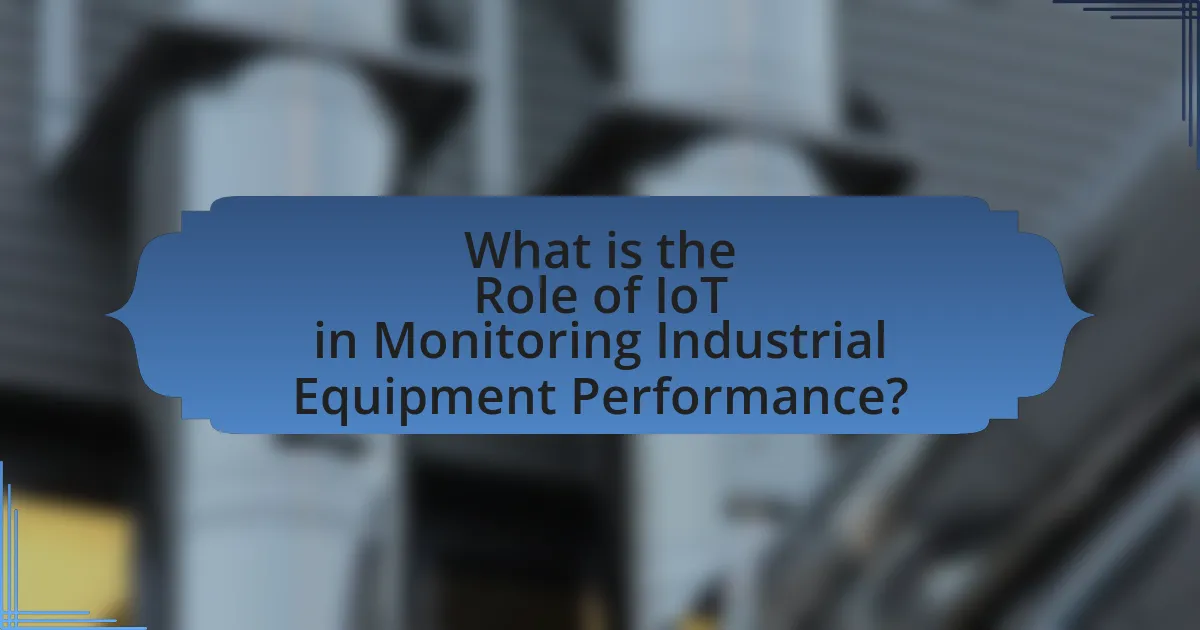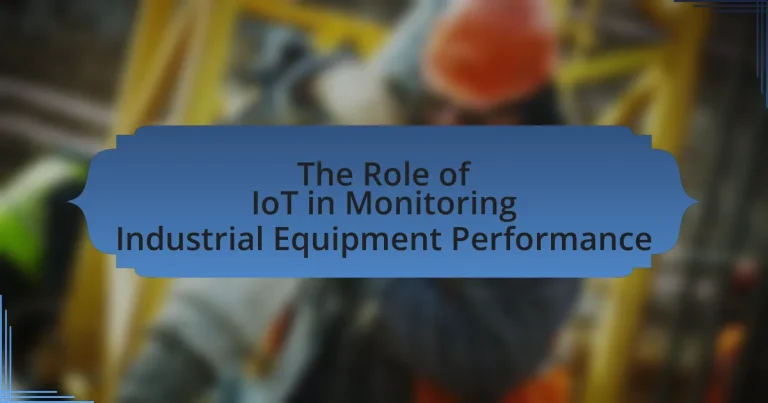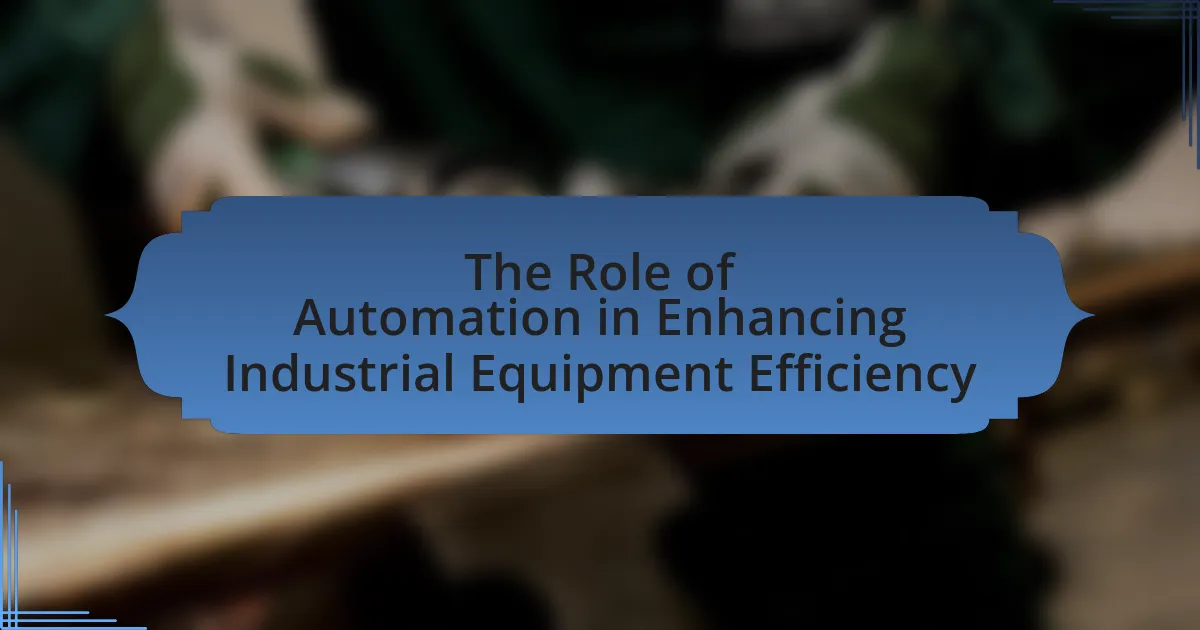The article focuses on the role of the Internet of Things (IoT) in monitoring industrial equipment performance. It highlights how IoT enables real-time data collection and analysis through sensors and connected devices, facilitating predictive maintenance and enhancing operational efficiency. Key components of IoT systems, such as sensors, connectivity, and data processing, are discussed, along with the benefits of reduced maintenance costs and increased equipment uptime. The article also addresses challenges in IoT implementation, including data security and interoperability, while exploring future trends and best practices for effective deployment in industrial settings.
What is the Role of IoT in Monitoring Industrial Equipment Performance?

The Internet of Things (IoT) plays a crucial role in monitoring industrial equipment performance by enabling real-time data collection and analysis. IoT devices, such as sensors and connected machinery, continuously gather performance metrics, including temperature, vibration, and operational efficiency. This data allows for predictive maintenance, reducing downtime and operational costs. According to a report by McKinsey, IoT applications in manufacturing can lead to a 10-20% reduction in maintenance costs and a 20-30% increase in equipment uptime. Thus, IoT significantly enhances the ability to monitor and optimize industrial equipment performance effectively.
How does IoT technology facilitate equipment monitoring?
IoT technology facilitates equipment monitoring by enabling real-time data collection and analysis from connected devices. This connectivity allows for continuous tracking of equipment performance metrics such as temperature, vibration, and operational status. For instance, sensors integrated into machinery can transmit data to a centralized system, allowing operators to detect anomalies and predict maintenance needs before failures occur. According to a report by McKinsey, companies that implement IoT solutions can reduce equipment downtime by up to 30% and maintenance costs by 25%, demonstrating the effectiveness of IoT in enhancing operational efficiency and reliability.
What are the key components of IoT systems used in industrial monitoring?
The key components of IoT systems used in industrial monitoring include sensors, connectivity, data processing, and user interfaces. Sensors collect real-time data from industrial equipment, such as temperature, pressure, and vibration levels. Connectivity enables the transmission of this data to cloud platforms or local servers through various communication protocols like Wi-Fi, LoRa, or cellular networks. Data processing involves analyzing the collected information using algorithms and machine learning techniques to derive actionable insights. Finally, user interfaces, such as dashboards and mobile applications, allow operators to visualize the data and make informed decisions. These components work together to enhance operational efficiency and predictive maintenance in industrial settings.
How do sensors and data analytics contribute to performance monitoring?
Sensors and data analytics significantly enhance performance monitoring by providing real-time data and insights into equipment operations. Sensors collect various metrics such as temperature, pressure, and vibration, which are crucial for assessing the health and efficiency of industrial equipment. Data analytics processes this information to identify patterns, predict failures, and optimize performance. For instance, predictive maintenance models can analyze historical sensor data to forecast when a machine is likely to fail, allowing for timely interventions that reduce downtime and maintenance costs. This integration of sensors and analytics leads to improved operational efficiency and resource management in industrial settings.
What are the primary benefits of using IoT for equipment performance monitoring?
The primary benefits of using IoT for equipment performance monitoring include real-time data collection, predictive maintenance, and enhanced operational efficiency. Real-time data collection allows for continuous monitoring of equipment conditions, enabling immediate responses to anomalies. Predictive maintenance leverages data analytics to forecast equipment failures before they occur, reducing downtime and maintenance costs. Enhanced operational efficiency is achieved through optimized resource allocation and improved decision-making based on accurate performance insights. These benefits collectively lead to increased productivity and reduced operational risks in industrial settings.
How does IoT improve operational efficiency in industrial settings?
IoT improves operational efficiency in industrial settings by enabling real-time monitoring and data analysis of equipment performance. This technology allows for predictive maintenance, which reduces downtime by identifying potential failures before they occur. For instance, a study by McKinsey & Company found that predictive maintenance can reduce maintenance costs by 10-40% and increase equipment uptime by 10-20%. Additionally, IoT facilitates better resource management through automation and optimization of processes, leading to increased productivity and reduced operational costs.
What cost savings can be achieved through IoT monitoring?
IoT monitoring can achieve significant cost savings by optimizing operational efficiency and reducing downtime. By utilizing real-time data analytics, businesses can identify equipment failures before they occur, leading to proactive maintenance that minimizes repair costs and extends asset lifespan. For instance, a study by McKinsey & Company found that predictive maintenance can reduce maintenance costs by 10-40% and decrease equipment downtime by 50%. Additionally, IoT monitoring can streamline energy consumption, resulting in lower utility bills; research indicates that IoT solutions can lead to energy savings of up to 30%. These factors collectively contribute to substantial overall cost reductions in industrial operations.
What challenges are associated with implementing IoT in industrial equipment monitoring?
Implementing IoT in industrial equipment monitoring faces several challenges, including data security, interoperability, and scalability. Data security is critical as IoT devices are vulnerable to cyberattacks, which can lead to unauthorized access and data breaches. According to a report by IBM, 95% of security incidents involve human error, highlighting the need for robust security protocols. Interoperability issues arise from the diverse range of devices and protocols used in industrial settings, making it difficult for systems to communicate effectively. A study by McKinsey indicates that 70% of IoT projects fail due to integration challenges. Lastly, scalability concerns emerge as organizations must ensure that their IoT solutions can grow with their operations without compromising performance or reliability.
How can data security concerns impact IoT deployment?
Data security concerns can significantly hinder IoT deployment by creating barriers to adoption and increasing operational costs. Organizations may delay or avoid implementing IoT solutions due to fears of data breaches, which can lead to financial losses and reputational damage. For instance, a report by IBM indicates that the average cost of a data breach is approximately $4.24 million, which can deter companies from investing in IoT technologies. Additionally, stringent regulatory requirements, such as GDPR, compel organizations to ensure robust data protection measures, further complicating the deployment process. Consequently, these security concerns can limit the scalability and effectiveness of IoT applications in monitoring industrial equipment performance.
What are the common technical issues faced during implementation?
Common technical issues faced during the implementation of IoT in monitoring industrial equipment performance include connectivity problems, data integration challenges, and security vulnerabilities. Connectivity issues often arise due to unreliable network infrastructure, which can hinder real-time data transmission. Data integration challenges occur when disparate systems and devices fail to communicate effectively, leading to inconsistent data and operational inefficiencies. Security vulnerabilities are a significant concern, as IoT devices can be susceptible to cyberattacks, potentially compromising sensitive operational data. According to a report by McKinsey & Company, 30% of IoT projects fail due to these technical challenges, highlighting the importance of addressing them during implementation.
How does IoT integration enhance predictive maintenance strategies?
IoT integration enhances predictive maintenance strategies by enabling real-time data collection and analysis from industrial equipment. This continuous monitoring allows for the identification of potential failures before they occur, significantly reducing downtime and maintenance costs. For instance, a study by McKinsey & Company found that predictive maintenance can reduce maintenance costs by 10-40% and unplanned downtime by 50%. By leveraging IoT sensors, organizations can track equipment performance metrics such as temperature, vibration, and operational hours, facilitating timely interventions and optimizing maintenance schedules based on actual usage rather than fixed intervals.
What role does real-time data play in predictive maintenance?
Real-time data is crucial in predictive maintenance as it enables immediate monitoring and analysis of equipment conditions. This continuous flow of information allows for the identification of potential failures before they occur, thereby reducing downtime and maintenance costs. For instance, sensors can track temperature, vibration, and other operational parameters, providing insights that lead to timely interventions. According to a study by McKinsey & Company, predictive maintenance can reduce maintenance costs by 10-40% and unplanned downtime by 50%. This demonstrates that real-time data not only enhances operational efficiency but also significantly impacts overall productivity in industrial settings.
How can IoT help in identifying potential equipment failures before they occur?
IoT can help identify potential equipment failures before they occur by continuously monitoring equipment conditions through sensors that collect real-time data on parameters such as temperature, vibration, and pressure. This data is analyzed using predictive analytics to detect anomalies that may indicate impending failures. For instance, a study by McKinsey & Company found that predictive maintenance enabled by IoT can reduce equipment downtime by 30-50% and maintenance costs by 10-40%. By leveraging this technology, industries can proactively address issues, thereby enhancing operational efficiency and reducing unexpected breakdowns.
What industries are most impacted by IoT in equipment performance monitoring?
The industries most impacted by IoT in equipment performance monitoring are manufacturing, healthcare, transportation, and energy. In manufacturing, IoT enables real-time monitoring of machinery, leading to improved efficiency and reduced downtime. In healthcare, IoT devices track medical equipment performance, enhancing patient care and operational efficiency. The transportation industry benefits from IoT through fleet management systems that monitor vehicle performance and optimize routes. Lastly, the energy sector utilizes IoT for monitoring equipment like turbines and transformers, which helps in predictive maintenance and energy efficiency. These industries leverage IoT technologies to enhance operational performance and reduce costs.
How is IoT transforming manufacturing processes?
IoT is transforming manufacturing processes by enabling real-time monitoring and data analytics of industrial equipment. This transformation allows manufacturers to optimize operations, reduce downtime, and enhance productivity. For instance, IoT sensors can track machine performance and predict maintenance needs, leading to a 10-20% reduction in maintenance costs, as reported by the McKinsey Global Institute. Additionally, the integration of IoT in manufacturing facilitates improved supply chain management through better inventory tracking and demand forecasting, which can increase efficiency by up to 30%.
What specific applications of IoT are prevalent in the energy sector?
Specific applications of IoT prevalent in the energy sector include smart grid management, predictive maintenance, and energy consumption monitoring. Smart grid management utilizes IoT devices to enhance the efficiency and reliability of electricity distribution by enabling real-time data collection and analysis. Predictive maintenance employs IoT sensors to monitor equipment health, allowing for timely interventions that reduce downtime and maintenance costs. Energy consumption monitoring involves the use of IoT-enabled meters that provide detailed insights into energy usage patterns, facilitating better energy management and conservation strategies. These applications collectively contribute to improved operational efficiency and sustainability in the energy sector.
What future trends can we expect in IoT and industrial equipment monitoring?
Future trends in IoT and industrial equipment monitoring include increased adoption of artificial intelligence for predictive maintenance, enhanced data analytics capabilities, and the integration of 5G technology. The use of AI allows for real-time analysis of equipment performance, enabling companies to predict failures before they occur, thus reducing downtime and maintenance costs. Enhanced data analytics will facilitate more informed decision-making by providing deeper insights into operational efficiency and equipment health. The integration of 5G technology will improve connectivity and data transfer speeds, allowing for more reliable and timely monitoring of industrial equipment across vast networks. These trends are supported by industry reports indicating that the global IoT in manufacturing market is expected to grow significantly, reaching $263 billion by 2027, highlighting the increasing reliance on IoT solutions for operational efficiency.
How will advancements in AI and machine learning influence IoT monitoring?
Advancements in AI and machine learning will significantly enhance IoT monitoring by enabling real-time data analysis and predictive maintenance. These technologies allow IoT devices to process vast amounts of data quickly, identifying patterns and anomalies that human operators might miss. For instance, machine learning algorithms can analyze historical performance data from industrial equipment to predict failures before they occur, reducing downtime and maintenance costs. According to a report by McKinsey, predictive maintenance can reduce maintenance costs by 10-40% and downtime by 50%. This integration of AI and machine learning into IoT monitoring systems leads to more efficient operations, improved safety, and optimized resource allocation in industrial settings.
What emerging technologies are likely to enhance IoT capabilities?
Emerging technologies likely to enhance IoT capabilities include edge computing, artificial intelligence (AI), and 5G connectivity. Edge computing reduces latency by processing data closer to the source, which is crucial for real-time monitoring of industrial equipment. AI enhances IoT by enabling predictive maintenance through data analysis, allowing for timely interventions that prevent equipment failures. Additionally, 5G connectivity provides higher bandwidth and lower latency, facilitating faster data transmission and improved communication between devices. These technologies collectively improve the efficiency, reliability, and scalability of IoT applications in industrial settings.
What best practices should be followed for effective IoT implementation in monitoring?
Effective IoT implementation in monitoring requires a clear strategy, robust security measures, and seamless integration with existing systems. A well-defined strategy ensures that the objectives of monitoring are aligned with business goals, facilitating targeted data collection and analysis. Implementing strong security protocols, such as encryption and regular updates, protects sensitive data from cyber threats, which is critical given that 70% of IoT devices are vulnerable to attacks. Additionally, integrating IoT solutions with existing infrastructure enhances data flow and operational efficiency, as evidenced by a study from McKinsey, which found that companies that effectively integrate IoT can achieve up to a 30% increase in productivity.
How can organizations ensure data integrity and security in IoT systems?
Organizations can ensure data integrity and security in IoT systems by implementing robust encryption protocols and regular security audits. Encryption protects data during transmission and storage, making it inaccessible to unauthorized users. Regular security audits help identify vulnerabilities and ensure compliance with industry standards, such as ISO/IEC 27001, which provides a framework for managing sensitive information securely. Additionally, employing strong authentication mechanisms, such as multi-factor authentication, further enhances security by ensuring that only authorized personnel can access the IoT devices and data.
What steps should be taken to train staff on IoT technologies?
To train staff on IoT technologies, organizations should implement a structured training program that includes hands-on workshops, online courses, and real-world applications. This approach ensures that employees gain practical experience and theoretical knowledge essential for understanding IoT systems.
Workshops can focus on specific IoT tools and platforms, allowing staff to engage directly with the technology. Online courses can provide foundational knowledge about IoT concepts, protocols, and security measures. Additionally, integrating real-world case studies related to industrial equipment performance can enhance learning by demonstrating the practical implications of IoT in their work environment.
Research indicates that companies that invest in comprehensive training programs see a 20% increase in employee productivity and a 30% reduction in operational errors, highlighting the effectiveness of structured training in improving staff competency in IoT technologies.




